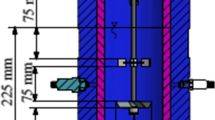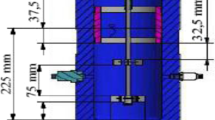Abstract
Natural gas hydrates (NGH) are proposed as gas storage and transportation media owing to their high gas content and long-term stability of hydrate crystal structure at common refrigeration temperatures and atmospheric pressure. Technically feasible, cost efficient hydrate production is one of the crucial items of the whole chain of storage and transportation of gas by means of NGH technology. This study investigates the effects of types and number of impellers and baffles. Single impeller experiments showed that hydrate formation rates of rushton turbine (RT) experiments are always higher than hydrate formation rates of pitched blade turbines upward pumping (PBTU) experiments for all types of baffles but on the other side RT experiments consume more energy. Hydrate yield values are always higher in the RT experiments showing that although the duration of hydrate formation process lasts less compared to PBTU ones, the amount of water that is converted to gas hydrates is more in RT experiments. The same results observed also in dual impeller experiments with the objection that values were closer. In single impeller experiments only PBTU experiments formed hydrates for 3 h while in dual experiments formed PBTU with full baffle and RT with no baffle experiments indicating a serious heat transfer limitations for the other experiments. It should be mentioned that PBT is the same with PBTU since all mixed flow experiments worked in upward pumping.














Similar content being viewed by others
References
Sloan ED Jr (1998) Clathrate hydrates of natural gases, 2nd edn. CRC Press, Boca Raton
Sloan ED Jr, Koh C (2007) Clathrate hydrates of natural gases. CRC Press, Boca Raton
Makogon IUrF, Cieslewicz W (1981) Hydrates of natural gas. Penn Well Books Tulsa, Oklahoma
Ripmeester JA, Tse JS, Ratcliffe CI, Powell BM (1987) A new clathratehydrate structure. Nature 325:135–136
Sum AK, Burruss RC, Sloan ED (1997) Measurement of clathrate hydrates via Raman spectroscopy. J Phys Chem B 101:7371–7377
Mao WL, Goncharov AF, Struzhkin VV, Guo Q, Hu J, Shu J, Hemley RJ, Somayazulu M, Zhao Y (2002) Hydrogen clusters in clathrate hydrate. Science 297:2247–2249
Kumar R, Linga P, Moudrakovski I, Ripmeester JA, Englezos P (2008) Structure and kinetics of gas hydrates from methane/ethane/propane mixtures relevant to the design of natural gas hydrate storage and transport facilities. AIChE 54:2132–2144
Kvenvolden K (2003) Natural gas hydrate: background and history of discovery. In: Max M (ed) Natural gas hydrate. Springer, Netherlands, pp 9–16
Carson DB, Katz DL (1942) Natural gas hydrates. Trans AIME 146:150–158
Zhanga J, Wanga Z, Liub S, Zhangc W, Yua J, Suna B (2019) Prediction of hydrate deposition in pipelines to improve gas transportation efficiency and safety. Appl Energy 253:113521
Zhang J, Wang Z, Duan W, Fu W, Sun B, Sun JS, Tong S (2020) Real-time estimation and management of hydrate plugging risk during deepwater gas well testing. SPE 25(6):3250–3264
Yang W, Wei G, Xie W, Jin H, Zeng F, Su N, Sun A, Shen MS, Wu JS (2020) Hydrocarbon accumulation and exploration prospect of mound-shoal complexes on the platform margin of the fourth member of Sinian Dengying Formation in the east of Mianzhu-Changning intracratonic rift Sichuan Basin, SW China. Pet Explor Dev 47(6):1262–1274
Shahnazar S, Hasan N (2014) Gas hydrate formation condition: review on experimental and modeling approaches. Fluid Phase Equilib 379:72–85
Ansari F, Soofivand F, Salavati-Niasari M (2015) Utilizing maleic acid as a novel fuel for synthesis of PbFe12O19 nanoceramics via sol–gel auto-combustion route. Mater Charact 103:11–17
Merey S, Longinos SN (2008) The role od natural gas hydrate during natural gas transportation. Omer HalisdemirUniv J EngSci 7(2):937–953
Englezos P, Lee JD (2005) Gas hydrates: a cleaner source of energy and opportunity for innovative technologies. Korean J Chem Eng 22:671–681
Klauda JB, Sandler SI (2005) Global distribution of methane hydrate in ocean sediment. Energy Fuels 19:459–470
Wang Z, Zhang J, Sun B, Chen L, Zhao Y, Fu W (2017) A new hydrate deposition prediction model for gas-dominated systems with free water. Chem Eng Sci 163:145–154
Sun ZG, Wang R, Ma R, Guo K, Fan S (2003) Natural gas storage in hydrates with the presence of promoters. Energy Convers Manag 44:2733–2742
Masoudi R, Tohidi B (2005) Gas hydrate production technology for natural gas storage and transportation and CO2 sequestration. In: SPE Middle East Oil and Gas Show and Conference, 12–15 March, Society of Petroleum Engineers, Kingdom of Bahrain
Ogata K, Hashimoto S, Sugahara T, Moritoki M, Sato H, Ohgaki K (2008) Storage capacity of hydrogen in tetrahydrofuran hydrate. ChemEngSci 63:5714–5718
Nagata T, Tajima H, Yamasaki A, Kiyono F, Abe Y (2009) An analysis of gas separation processes of HFC-134a from gaseous mixtures with nitrogen—Comparison of two types of gas separation methods, liquefaction and hydrate-based methods, in terms of the equilibrium recovery ratio. Sep Purif Technol 64:351–356
Eslamimanesh A, Mohammadi AH, Richon D, Naidoo P, Ramjugernath D (2012) Application of gas hydrate formation in separation processes: a review of experimental studies. J ChemThermodyn 46:62–71
Rajnauth JJ, Barrufet M, Falcone G (2010) Potential industry applications using gas hydrate technology. In: Trinidad and Tobago Energy Resources Conference. Society of Petroleum Engineers: Port of Spain, Trinidad, 2010
Li X-S, Xia Z-M, Chen Z-Y, Wu H-J (2011) Precombustion capture of carbon dioxide and hydrogen with a one-stage hydrate/ membrane process in the presence of tetra-n-butylammonium bromide (TBAB). Energy Fuels 25:1302–1309
Kang SP, Lee J, Seo Y (2013) Pre-combustion capture of CO2 by gas hydrate formation in silica gel pore structure. J ChemEng 218:126–132
Mehta AP, Hebert PB, Cadena R, Weatherman JP (2003) Fulfilling the promise of low-dosage hydrate inhibitors: journey from academic curiosity to successful field implementation. Offshore Technology Conference, 6–9 May, Houston, Texas, 2003
Lang X, Fan S, Wang Y (2010) Intensification of methane and hydrogen storage in clathrate hydrate and future prospect. J Nat Gas Chem 19:203–209
Rossi F, Filipponi M, Castellani B (2012) Investigation on a novel raector for gas hydrate production. Appl Energy 99:167–172
Kanda H (2006) Economic study on natural gas transportation with natural gas hydrate (NGH) pellets. In: Proceeding of the 23rd world gas conference, Amsterdam, 2006
Rossi F, Cotana F, Castellani B, Filipponi M (2010) Nuovo reattore sperimentale per la produzione di gas idrati. In: Proceedings of the X National Congress CIRIAF, Perugia, 2010
Hao W, Wang J, Fan S, Wenbin H (2007) Study on methane hydration process in a semi-continuous stirred tank reactor. Energy Convers Manag 48:954–960
Longinos SN, Parlaktuna M (2020) The effect of experimental conditions on methane (95%)-propane (5%) hydrate formation. Energies 13:6710. https://doi.org/10.3390/en13246710
Longinos SN, Parlaktuna M (2021) Kinetic analysis of methane-propane hydrate formation by the use of different impellers. ACS Omega. https://doi.org/10.1021/acsomega.0c05615
Lee BI, Kesler MG (1975) Generalized thermodynamic correlation based on three parameter corresponding states. AIChE 21:510–527
Stoots CM, Calabrese RV (1995) Mean velocity field relative to a Rushton turbine blade. AIChE 41:1–11. https://doi.org/10.1002/aic.690410102
Ameur H, Kamla Y, Sahel D (2016) CFD simulations of mixing characteristics of radial impellers in cylindrical reactors. ChemistrySelect 1:2548–2551
Youcefi S, Bouzit M, Ameur H, Kamla Y, Youcefi A (2013) Effect of some design parameters on the flow fields and power consumption in a vessel stirred by a Rushton turbine. Chem Process Eng 34(2):293–307. https://doi.org/10.2478/cpe-2013-0024
Yoon HS, Hill DF, Balachandar S, Adrian RJ, Ha MY (2005) Reynolds number scaling of flowin a Rushton turbine stirred tank. Part I—Mean flow, circular jet and tip vortex scaling. ChemEngSci 60:3169–3183. https://doi.org/10.1016/j.ces.2004.12.039
Houari A, Mohamed B, Abdellah G (2015) Numerical study of the performance of multistage Scaba 6SRGT impellers for the agitation of yield stress fluids in cylindrical tanks. J Hydrodyn 27(3):436–442
Acknowledgements
We are grateful to Mr Ozgur Ilker Coban for his assistance in the process of experiments.
Author information
Authors and Affiliations
Corresponding author
Additional information
Publisher's Note
Springer Nature remains neutral with regard to jurisdictional claims in published maps and institutional affiliations.
Supplementary Information
Below is the link to the electronic supplementary material.
Rights and permissions
About this article
Cite this article
Longinos, S.N., Parlaktuna, M. The effect of experimental conditions on methane hydrate formation by the use of single and dual impellers. Reac Kinet Mech Cat 132, 771–794 (2021). https://doi.org/10.1007/s11144-021-01937-6
Received:
Accepted:
Published:
Issue Date:
DOI: https://doi.org/10.1007/s11144-021-01937-6




